Phenolic Compounds from Carissa spinarum Are Characterized by Their Antioxidant, Anti-Inflammatory and Hepatoprotective Activities
Abstract
1. Introduction
2. Materials and Methods
2.1. Plant Material
2.2. Reagents and Instrumentation
2.3. Extraction and Isolation
2.4. In Vitro Antioxidant Activity Determination
2.4.1. DPPH Radical Scavenging Activity Assay
2.4.2. Ferric Reducing Antioxidant Power (FRAP) Assay
2.5. COX-2 Inhibition Assay
2.6. Hepatoprotective Property Assay
2.6.1. Establishment of H2O2-Induced Oxidative Stress Model in L02 Cells
2.6.2. Hepatoprotective Activity of Select Compounds on L02 Cells against H2O2-Induced Oxidative Stress
2.6.3. Quantitation and Photography of ROS in Hepatoprotective Assays
2.7. Statistical Analysis
3. Results and Discussion
3.1. In Vitro Antioxidant Activity Assays of C. spinarum Extracts
3.2. In Vitro COX-2 Inhibition Assays of C. spinarum Extracts
3.3. Structure Elucidation of Isolated Compounds from C. spinarum
3.4. In Vitro Antioxidant Activity Assays of Isolated Compounds
3.5. COX-2 Inhibition Activity Assays of Isolated Compounds
3.6. Hepatoprotective Properties of Select Compounds
3.6.1. Establishment of H2O2-induced L02 Injury Model
3.6.2. Protective Effects of Select Compounds on H2O2-Induced Injury in L02 Cells
4. Conclusions
Supplementary Materials
Author Contributions
Funding
Institutional Review Board Statement
Informed Consent Statement
Data Availability Statement
Conflicts of Interest
References
- Kaunda, J.S.; Zhang, Y.J. The genus Carissa: An ethnopharmacological, phytochemical and pharmacological review. Nat. Prod. Bioprospect. 2017, 7, 181–199. [Google Scholar] [CrossRef]
- Beck, N.R. A brief review on pharmacognostic, phytoconstituents, pharmacology and traditional uses of Carrisa spinarum (Apocynaceae). Int. J. Res. Pharm. Nano Sci. 2016, 5, 251–260. [Google Scholar]
- Bhadane, B.S.; Patil, M.P.; Patil, R.H.; Maheshwari, V.L. Ethnopharmacology, phytochemistry, and biotechnological advances of family Apocynaceae: A review. Phytother. Res. 2018, 32, 1181–1210. [Google Scholar] [CrossRef]
- Giday, M.; Asfaw, Z.; Elmqvist, T.; Woldu, Z. An ethnobotanical study of medicinal plants used by the Zay people in Ethiopia. J. Ethnopharmacol. 2003, 85, 43–52. [Google Scholar] [CrossRef]
- Wambugu, S.N.; Mathiu, P.M.; Gakuya, D.W.; Kanui, T.I.; Kabasa, J.D.; Kiama, S.G. Medicinal plants used in the management of chronic joint pains in Machakos and Makueni counties, Kenya. J. Ethnopharmacol. 2011, 137, 945–955. [Google Scholar] [CrossRef]
- Maobe, M.A.G.; Gitu, L.; Gatebe, E.; Rotich, H. Phytochemical analysis of phenol and flavonoid in eight selected medicinal herbs used for the treatment of diabetes, malaria and pneumonia in Kisii, Kenya. Academic, J. Cancer Res. 2012, 5, 31–39. [Google Scholar]
- Griesser, M.; Weingart, G.; Schoedl-Hummel, K.; Neumann, N.; Becker, M.; Varmuza, K.; Liebner, F.; Schuhmacher, R.; Forneck, A. Severe drought stress is affecting selected primary metabolites, polyphenols, and volatile metabolites in grapevine leaves (Vitis vinifera cv. Pinot noir). Plant Physiol. Biochem. 2015, 88, 17–26. [Google Scholar] [CrossRef] [PubMed]
- Kowalczewski, P.L.; Radzikowska, D.; Ivanisova, E.; Szwengiel, A.; Kacaniova, M.; Sawinska, Z. Influence of abiotic stress factors on the antioxidant properties and polyphenols profile composition of green barley (Hordeum vulgare L.). Int. J. Mol. Sci. 2020, 21, 397. [Google Scholar] [CrossRef]
- Espinos, C.; Galindo, M.I.; Garcia-Gimeno, M.A.; Ibanez-Cabellos, J.S.; Martinez-Rubio, D.; Millan, J.M.; Rodrigo, R.; Sanz, P.; Seco-Cervera, M.; Sevilla, T.; et al. Oxidative stress, a crossroad between rare diseases and neurodegeneration. Antioxidants 2020, 9, 313. [Google Scholar] [CrossRef] [PubMed]
- Ray, P.D.; Huang, B.W.; Tsuji, Y. Reactive oxygen species (ROS) homeostasis and redox regulation in cellular signaling. Cell. Signal. 2012, 24, 981–990. [Google Scholar] [CrossRef] [PubMed]
- Dumont, M.; Beal, M.F. Neuroprotective strategies involving ROS in Alzheimer disease. Free Radical Bio. Med. 2011, 51, 1014–1026. [Google Scholar] [CrossRef]
- Park, C.; Cha, H.J.; Lee, H.; Hwang-Bo, H.; Ji, S.Y.; Kim, M.Y.; Hong, S.H.; Jeong, J.W.; Han, M.H.; Choi, S.H.; et al. Induction of G2/M cell cycle arrest and apoptosis by genistein in human bladder cancer T24 cells through inhibition of the ROS-dependent PI3k/Akt signal transduction pathway. Antioxidants 2019, 8, 327. [Google Scholar] [CrossRef] [PubMed]
- Chen, Z.; Tian, R.; She, Z.; Cai, J.; Li, H. Role of oxidative stress in the pathogenesis of nonalcoholic fatty liver disease. Free Radical Bio. Med. 2020, 152, 116–141. [Google Scholar] [CrossRef]
- Cadenas, S. ROS and redox signaling in myocardial ischemia-reperfusion injury and cardioprotection. Free Radical Bio. Med. 2018, 117, 76–89. [Google Scholar] [CrossRef]
- Casas-Grajales, S.; Muriel, P. Chapter 43—The Liver, Oxidative Stress, and Antioxidants. In Liver Pathophysiology; Muriel, P., Ed.; Academic Press: Boston, MA, USA, 2017; pp. 583–604. [Google Scholar]
- Singal, A.K.; Jampana, S.C.; Weinman, S.A. Antioxidants as therapeutic agents for liver disease. Liver Int. 2011, 31, 1432–1448. [Google Scholar] [CrossRef]
- Ji, H.F.; Sun, Y.; Shen, L. Effect of vitamin E supplementation on aminotransferase levels in patients with NAFLD, NASH, and CHC: Results from a meta-analysis. Nutrition 2014, 30, 986–991. [Google Scholar] [CrossRef]
- Szymanska, R.; Pospisil, P.; Kruk, J. Plant-derived antioxidants in disease prevention 2018. Oxid. Med. Cell. Longev. 2018, 2018, 2068370. [Google Scholar] [CrossRef]
- Wangteeraprasert, R.; Lipipun, V.; Gunaratnam, M.; Neidle, S.; Gibbons, S.; Likhitwitayawuid, K. Bioactive compounds from Carissa spinarum. Phytother. Res. 2012, 26, 1496–1499. [Google Scholar] [CrossRef]
- Rao, R.J.; Kumar, U.S.; Reddy, S.V.; Tiwari, A.K.; Rao, J.M. Antioxidants and a new germacrane sesquiteroene from Carissa spinarum. Nat. Prod. Res. 2005, 19, 763–769. [Google Scholar]
- Hegde, K.; Joshi, A.B. Hepatoprotective and anti-oxidant effect of Carissa spinarum root extract against CCl4- and paracetamol-induced hepatic damage in rats. Bangladesh J. Pharmacol. 2010, 5, 73–76. [Google Scholar] [CrossRef]
- Li, S.S.; Jiang, M.; Wang, L.; Yu, S.W. Combined chemotherapy with cyclooxygenase-2 (COX-2) inhibitors in treating human cancers: Recent advancement. Biomed. Pharmacother. 2020, 129, 110389. [Google Scholar] [CrossRef] [PubMed]
- Han, H.; Desert, R.; Das, S.; Song, Z.L.; Athavale, D.; Ge, X.D.; Nieto, N. Danger signals in liver injury and restoration of homeostasis. J. Hepatol. 2020, 73, 933–951. [Google Scholar] [CrossRef]
- Salminen, A.; Ojala, J.; Kauppinen, A.; Kaarniranta, K.; Suuronen, T. Inflammation in Alzheimer’s disease: Amyloid-beta oligomers trigger innate immunity defence via pattern recognition receptors. Prog. Neurobiol. 2009, 87, 181–194. [Google Scholar] [CrossRef]
- Hu, Y.; Yang, X.F.; Wu, S.D.; Xiao, J.H. COX-2 in liver fibrosis. Clin. Chim. Acta 2020, 506, 196–203. [Google Scholar]
- Yu, H.Y.; Chen, Z.Y.; Sun, B.; Liu, J.J.; Meng, F.Y.; Liu, Y.; Tian, T.; Jin, A.; Ruan, H.L. Lignans from the fruit of Schisandra glaucescens with antioxidant and neuroprotective properties. J. Nat. Prod. 2014, 77, 1311–1320. [Google Scholar] [CrossRef]
- Xu, Y.B.; Chen, G.L.; Guo, M.Q. Antioxidant and anti-inflammatory activities of the crude extracts of Moringa oleifera from Kenya and their correlations with flavonoids. Antioxidants 2019, 8, 296. [Google Scholar] [CrossRef] [PubMed]
- Ma, J.; Li, M.; Kalavagunta, P.K.; Li, J.; He, Q.; Zhang, Y.; Ahmad, O.; Yin, H.; Wang, T.; Shang, J. Protective effects of cichoric acid on H2O2-induced oxidative injury in hepatocytes and larval zebrafish models. Biomed. Pharmacother. 2018, 104, 679–685. [Google Scholar] [CrossRef]
- Huang, L.; Jiang, W.; Zhu, L.; Ma, C.; Ou, Z.; Luo, C.; Wu, J.; Wen, L.; Tan, Z.; Yi, J. γ-Oryzanol suppresses cell apoptosis by inhibiting reactive oxygen species-mediated mitochondrial signaling pathway in H2O2-stimulated L02 cells. Biomed. Pharmacother. 2020, 121, 109554. [Google Scholar] [CrossRef]
- Wang, L.; Chen, Q.; Zhuang, S.; Wen, Y.; Cheng, W.; Zeng, Z.; Jiang, T.; Tang, C. Effect of Anoectochilus roxburghii flavonoids extract on H2O2-Induced oxidative stress in LO2 cells and D-gal induced aging mice model. J. Ethnopharmacol. 2020, 254, 112670. [Google Scholar] [CrossRef]
- Cerretani, L.; Bendini, A. Chapter 67—Rapid assays to evaluate the antioxidant capacity of phenols in virgin olive oil. In Olives and Olive Oil in Health and Disease Prevention; Preedy, V.R., Watson, R.R., Eds.; Academic Press: San Diego, CA, USA, 2010; pp. 625–635. [Google Scholar]
- Chauhan, A.; Tanwar, B.; Arneja, I. Influence of processing on physiochemical, nutritional and phytochemical composition of Carissa spinarum (karonda) fruit. Asian J. Pharm. Clin. Res. 2015, 8, 254–259. [Google Scholar]
- Feyissa, D.; Melaku, Y. Phytochemical, antibacterial and antioxidant studies of the leaves of Carissa spinarum. Int. J. Chem. Pharm. Sci. 2016, 7, 25–30. [Google Scholar]
- Patrignani, P.; Tacconelli, S.; Sciulli, M.G.; Capone, M.L. New insights into COX-2 biology and inhibition. Brain Res. Rev. 2005, 48, 352–359. [Google Scholar] [CrossRef]
- Beck, N.R.; Namdeo, K.P. Evaluation of in vivo anti-inflammatory activity of leaves extract of Carissa spinarum on formalin induced paw edema in albino rats. UK J. Pharm. Biosci. 2016, 4, 36–40. [Google Scholar] [CrossRef]
- Lendl, A.; Werner, I.; Glasl, S.; Kletter, C.; Mucaji, P.; Presser, A.; Reznicek, G.; Jurenitsch, J.; Taylor, D.W. Phenolic and terpenoid compounds from Chione venosa (sw.) URBAN var. venosa (Bois Bande). Phytochemistry 2005, 66, 2381–2387. [Google Scholar] [CrossRef] [PubMed]
- Chen, B.; Liu, Y.; Liu, H.W.; Wang, N.L.; Yang, B.F.; Yao, X.S. Iridoid and aromatic glycosides from Scrophularia ningpoensis HEMSL. and their inhibition of [Ca2+]i increase induced by KCl. Chem. Biodivers. 2008, 5, 1723–1735. [Google Scholar] [CrossRef] [PubMed]
- Li, J.; Kadota, S.; Kawata, Y.; Hattori, M.; Xu, G.J.; Namba, T. Constituents of the roots of Cynanchum bungei Decne. Isolation and structures of four new glucosides, Bungeiside-A., -B., -C., and -D. Chem. Pharm. Bull. 1992, 40, 3133–3137. [Google Scholar] [CrossRef]
- Yang, Y.L.; Chang, F.R.; Wu, Y.C. Squadinorlignoside: A novel 7,9′-dinorlignan from the stems of Annona squamosa. Helv. Chim. Acta 2005, 88, 2731–2737. [Google Scholar] [CrossRef]
- Zhong, X.N.; Ide, T.; Otsuka, H.; Hirata, E.; Takeda, Y. (+)-isolarisiresinol 3a-O-sulphate from leaves of Myrsine seguinii. Phytochemistry 1998, 49, 1777–1778. [Google Scholar] [CrossRef]
- Ohashi, K.; Watanabe, H.; Okumura, Y.; UJI, T.; Kitagawa, I. Indonesian medicinal plants. XII. Four isomaric lignan-glucosides from the bark of Aegle marmelos (Rutaceae). Chem. Pharm. Bull. 1994, 42, 1924–1926. [Google Scholar] [CrossRef]
- Balazs, B.; Toth, G.; Duddeck, H.; Soliman, H.S.M. Iridoid and lignan glycosides from Citharexylum spinosum L. Nat. Prod. Res. 2006, 20, 201–205. [Google Scholar] [CrossRef]
- Kim, T.H.; Kim, J.K.; Ito, H.; Jo, C. Enhancement of pancreatic lipase inhibitory activity of curcumin by radiolytic transformation. Bioorg. Med. Chem. Lett. 2011, 21, 1512–1514. [Google Scholar] [CrossRef] [PubMed]
- Ma, J.P.; Jin, X.L.; Yang, L.; Liu, Z.L. Diarylheptanoids from the rhizomes of Zingiber officinale. Phytochemistry 2004, 65, 1137–1143. [Google Scholar] [CrossRef]
- Banerjee, A.; Adak, M.M.; Das, S.; Banerjee, S.; Sengupta, S. Use of phosphorus pentoxide. Preparation of half-esters through selective esterification. J. Indian Chem. Soc. 1987, 64, 34–37. [Google Scholar]
- Wang, W.; Yang, C.R.; Zhang, Y.J. Phenolic constituents from the fruits of Amomum tsao-ko (Zingiberaceae). Acta Botanica Yunnanica 2009, 31, 284–288. [Google Scholar] [CrossRef]
- Shahidi, F.; Ambigaipalan, P. Phenolics and polyphenolics in foods, beverages and spices: Antioxidant activity and health effects—A review. J. Funct. Foods 2015, 18, 820–897. [Google Scholar] [CrossRef]
- Soleymani, S.; Habtemariam, S.; Rahimi, R.; Nabavi, S.M. The what and who of dietary lignans in human health: Special focus on prooxidant and antioxidant effects. Trends Food Sci. Technol. 2020, 106, 382–390. [Google Scholar] [CrossRef]
- Liu, Q.; Zhu, L.X.; Cheng, C.; Hu, Y.Y.; Feng, Q. Natural active compounds from plant food and Chinese herbal medicine for nonalcoholic fatty liver disease. Curr. Pharm. Design 2017, 23, 5136–5162. [Google Scholar] [CrossRef]
- Gunawardena, D.; Govindaraghavan, S.; Münch, G. Chapter 30—Anti-Inflammatory Properties of Cinnamon Polyphenols and Their Monomeric Precursors. In Polyphenols in Human Health and Disease; Watson, R.R., Preedy, V.R., Zibadi, S., Eds.; Academic Press: San Diego, CA, USA, 2014; pp. 409–425. [Google Scholar]
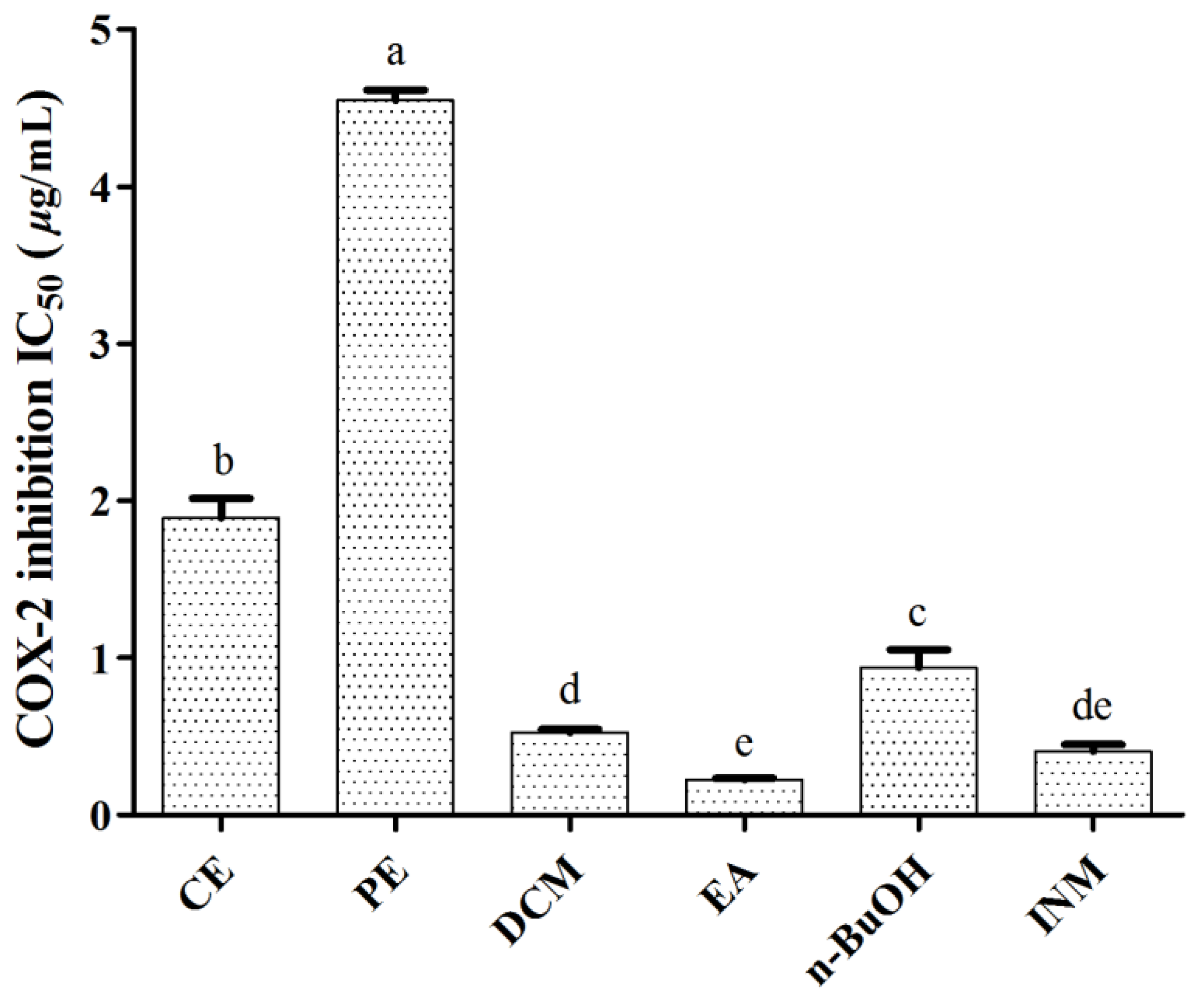

 ) and HMBC (→) correlations of compound 5.
) and HMBC (→) correlations of compound 5.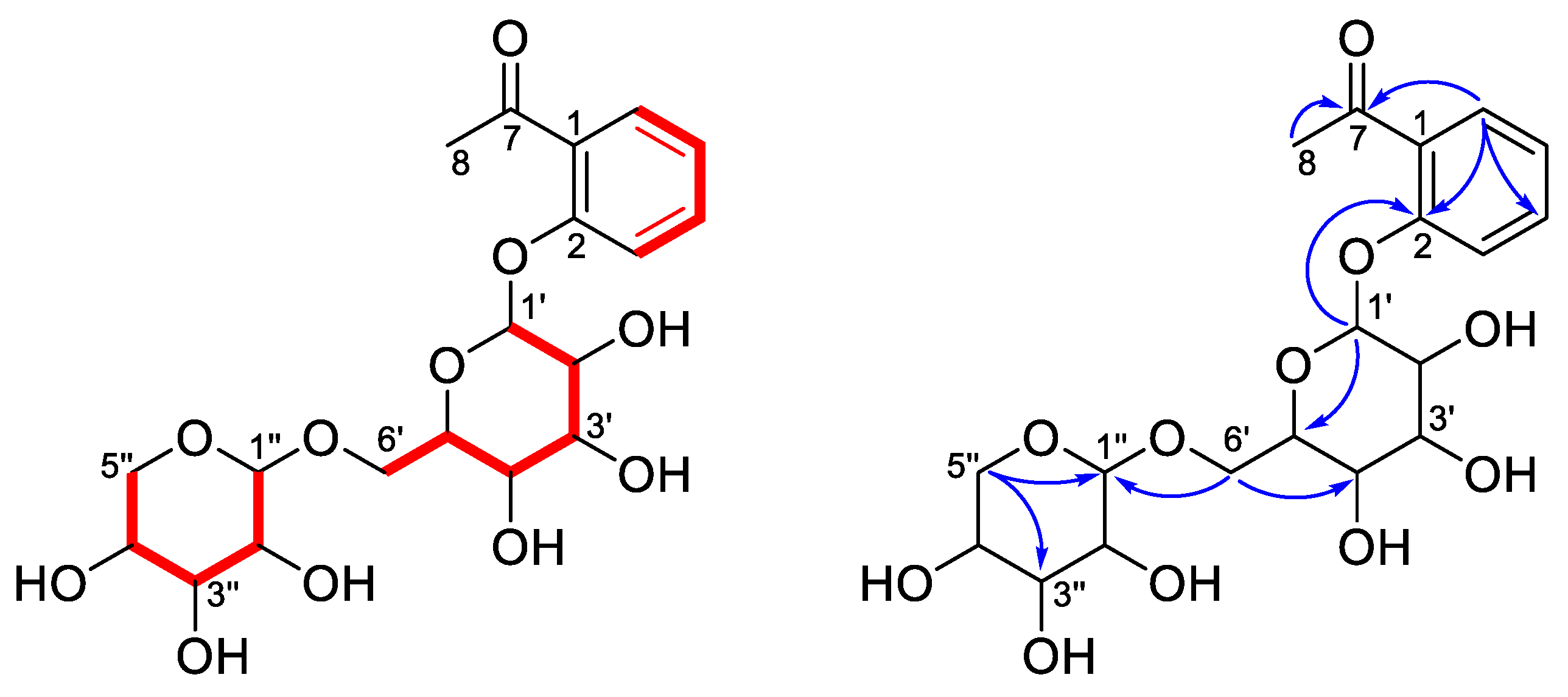
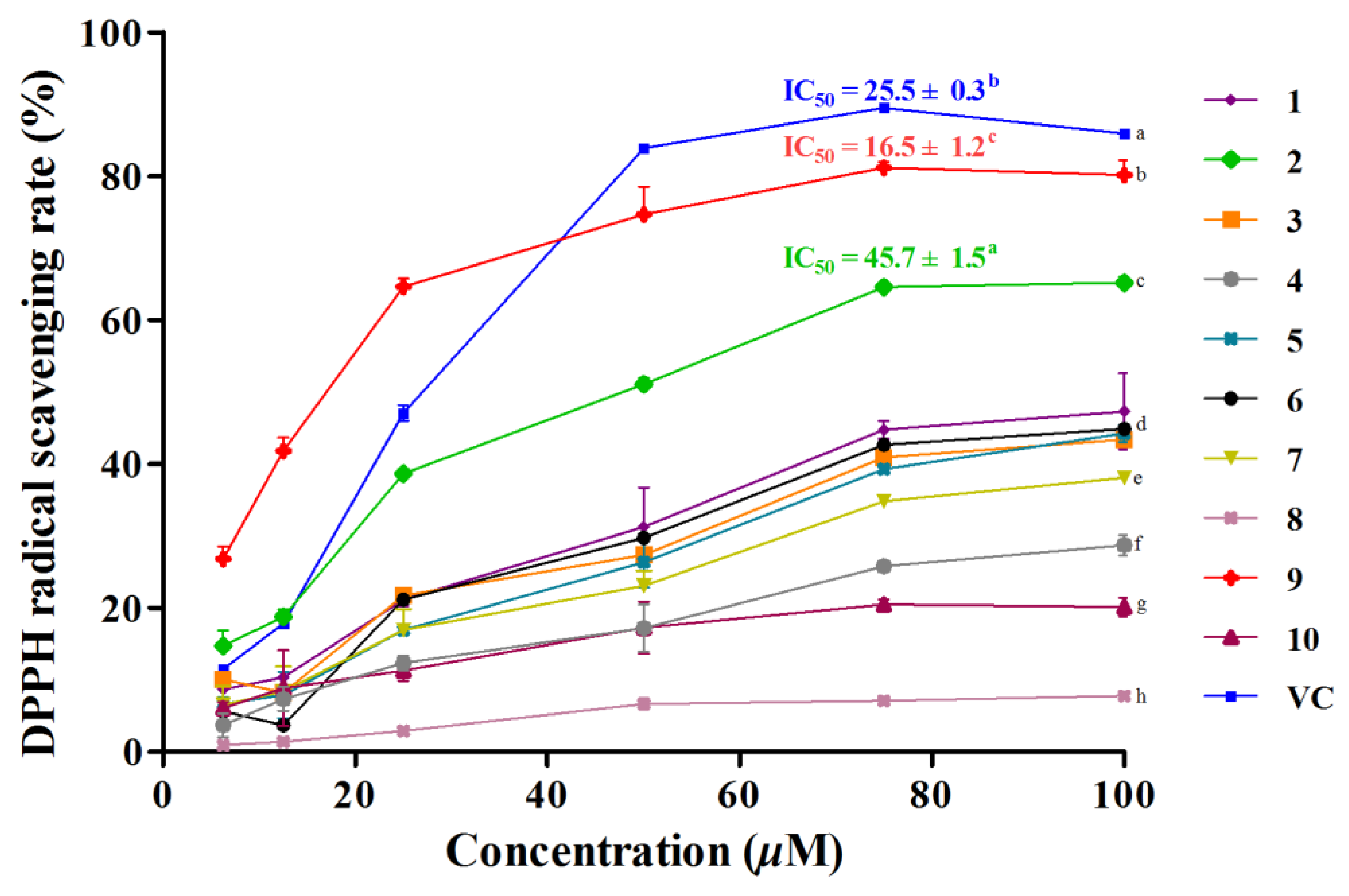
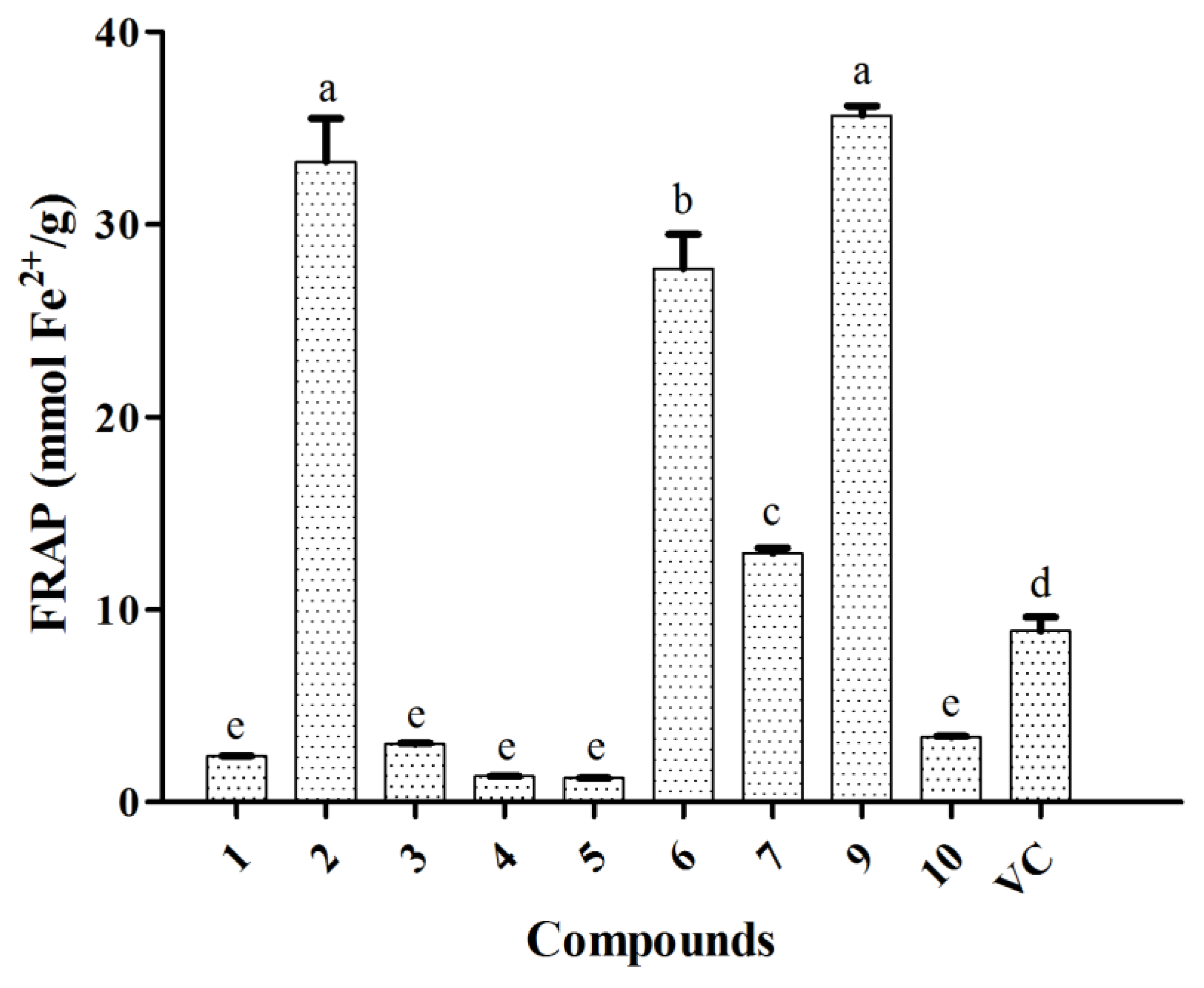


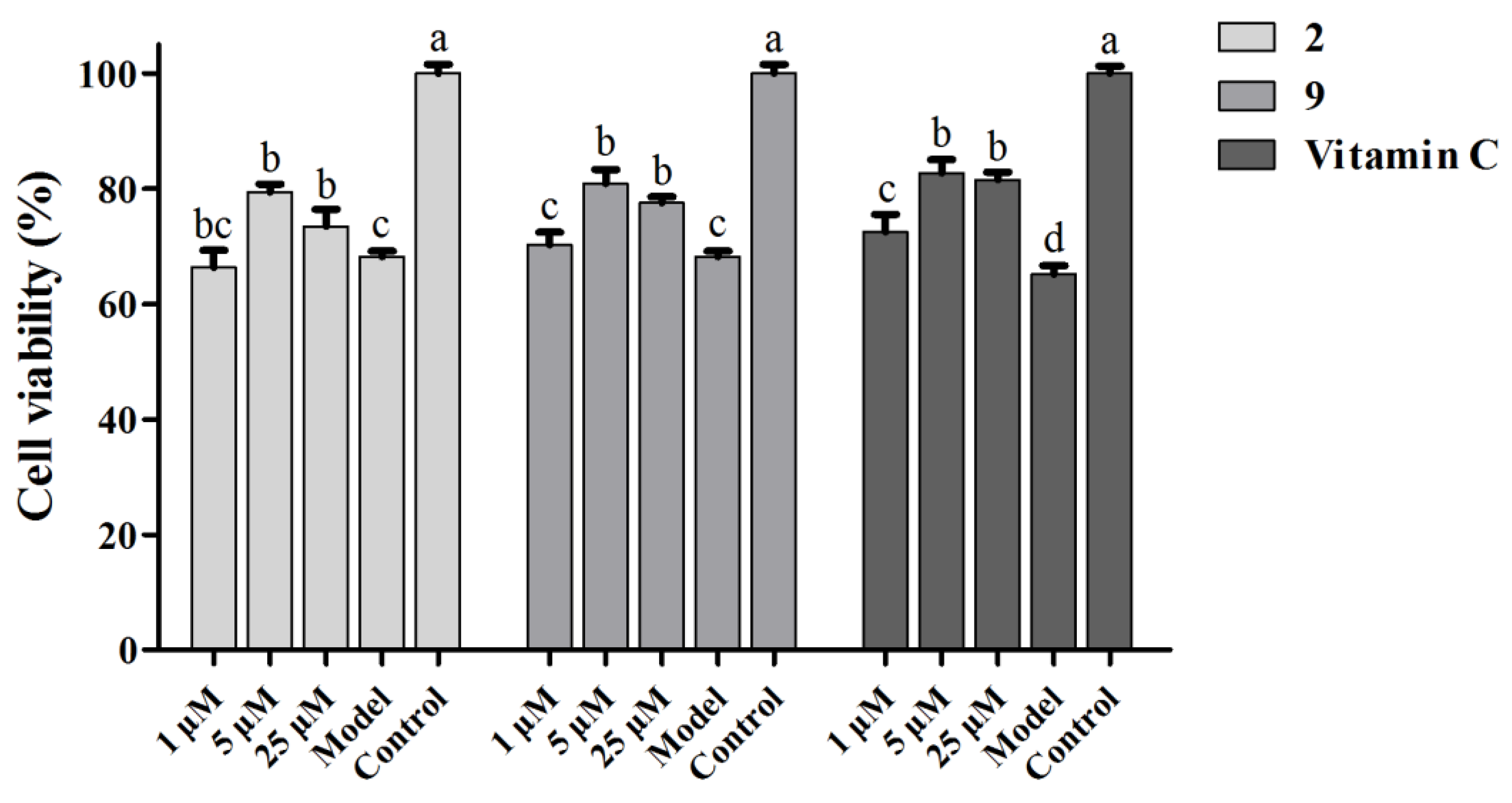
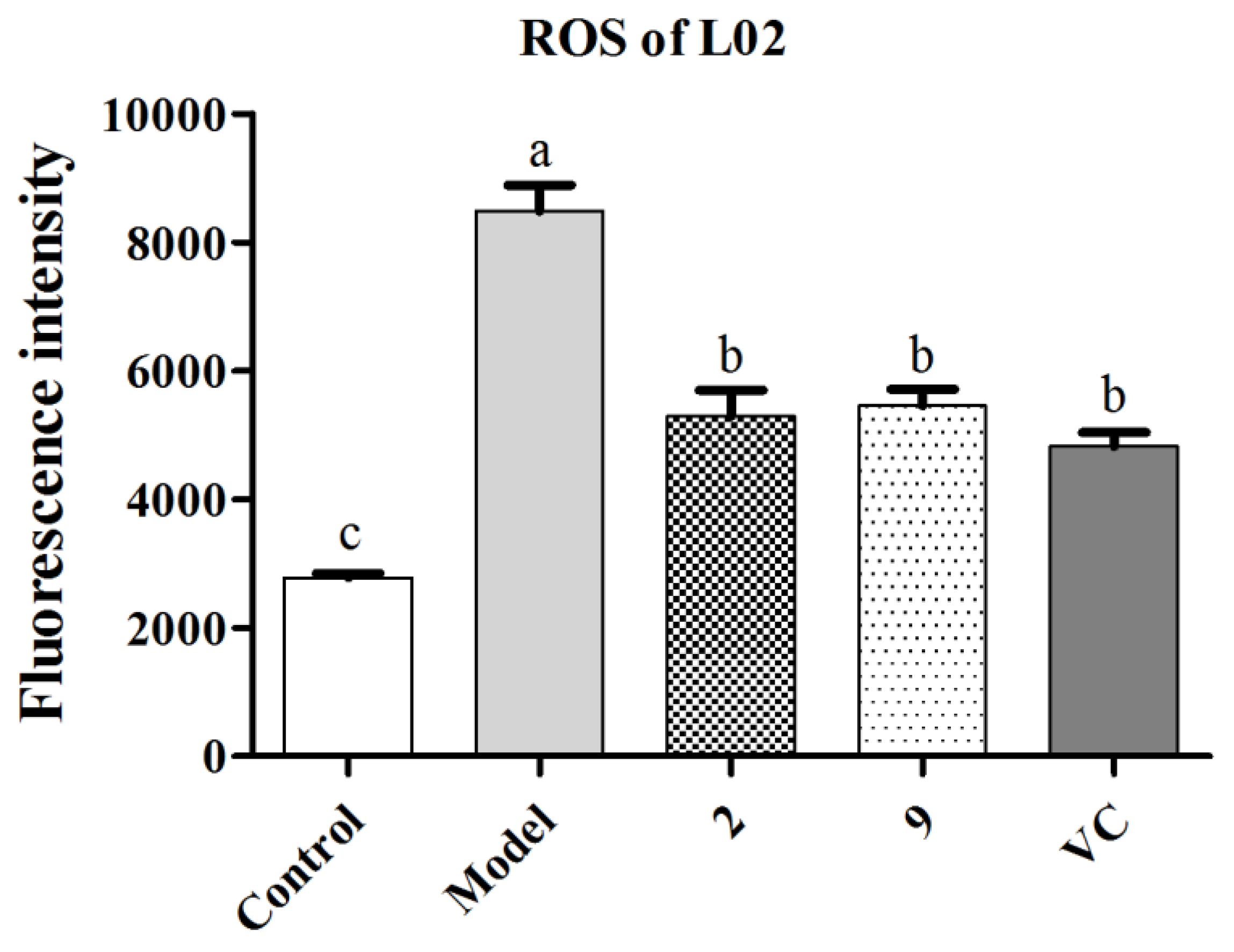
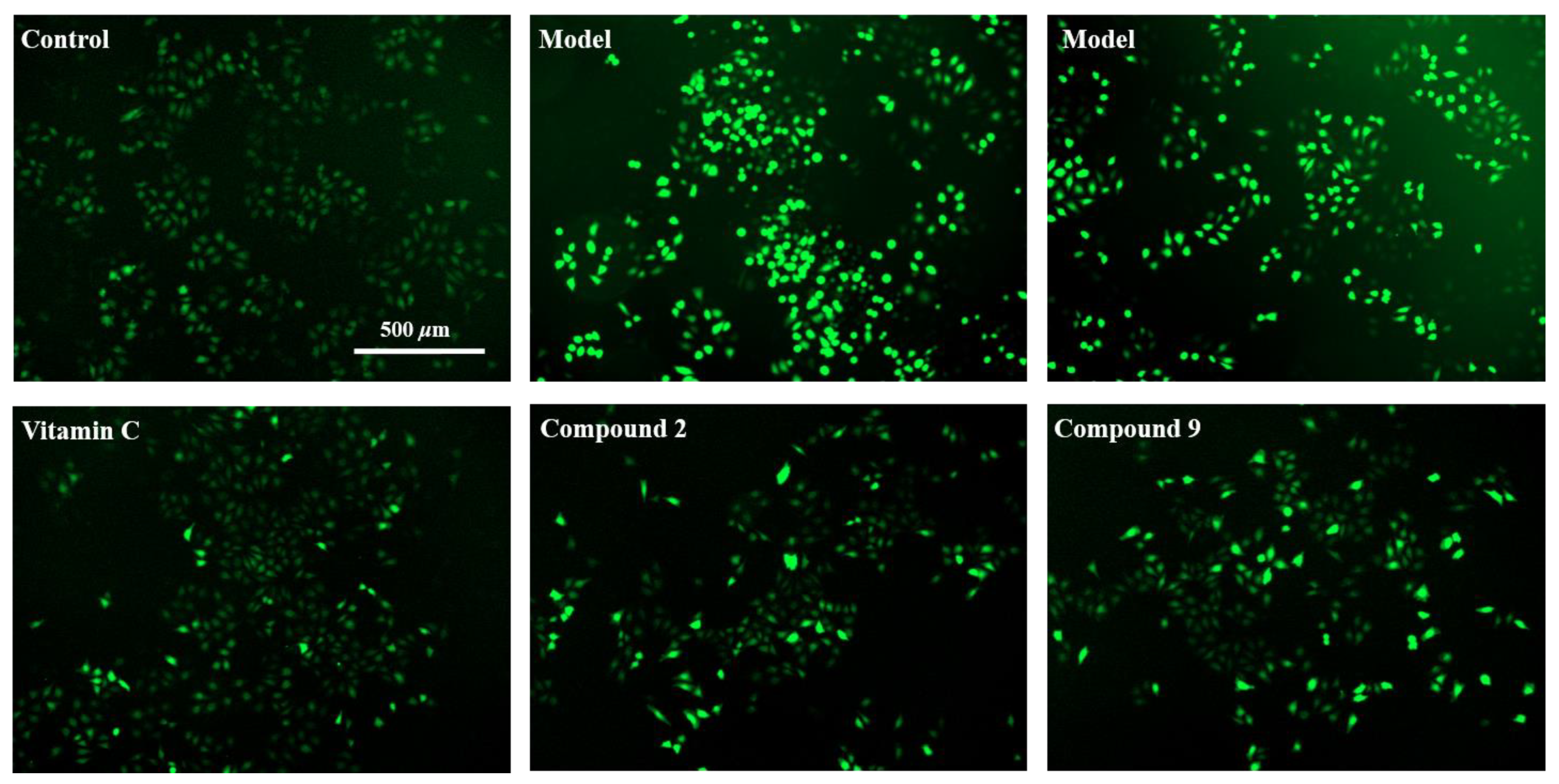
| Sample | DPPH 1 | FRAP 1 |
|---|---|---|
| IC50 (µg/mL) | mmol Fe2+/g | |
| CE | >500 | 0.2 ± 0.0 d |
| PE | >500 | 0.2 ± 0.0 d |
| DCM | 136.0 ± 7.6 a | 3.0 ± 0.7 c |
| EA | 31.8 ± 1.3 c | 14.9 ± 2.4 a |
| n-BuOH | 92.4 ± 8.6 b | 4.1 ± 0.0 c |
| Vitamin C | 4.5 ± 0.1 d | 8.9 ± 1.2 b |
| Position | δH, (J in Hz) | δC | Position | δH, (J in Hz) | δC |
|---|---|---|---|---|---|
| 1 | 130.4 | 4′ | 3.41, dd (9.8, 8.9) | 71.3 | |
| 2 | 158.0 | 5′ | 3.70, ddd (9.8, 6.4, 2.0) | 77.6 | |
| 3 | 7.39, dd (8.7, 1.0) | 117.6 | 6′a | 4.13, dd (11.7, 2.0) | 69.8 |
| 4 | 7.56, ddd (8.7, 7.5, 1.8) | 135.3 | 6′b | 3.79, dd (11.7, 6.4) | |
| 5 | 7.11, td (7.5, 1.0) | 123.4 | 1″ | 4.32, d (7.5) | 105.4 |
| 6 | 7.67, dd (7.5, 1.8) | 130.8 | 2″ | 3.21, dd (8.9, 7.5) | 75.0 |
| 7 | 202.5 | 3″ | 3.28, t (8.9) | 77.7 | |
| 8 | 2.69, s | 32.2 | 4″ | 3.48, m, overlap | 71.2 |
| 1′ | 5.04, d (7.7) | 102.4 | 5″a | 3.84, dd (11.5, 5.4) | 66.9 |
| 2′ | 3.55, dd (9.2, 7.7) | 74.9 | 5″b | 3.13, dd (11.5, 10.2) | |
| 3′ | 3.48, m, overlap | 78.1 |
Publisher’s Note: MDPI stays neutral with regard to jurisdictional claims in published maps and institutional affiliations. |
© 2021 by the authors. Licensee MDPI, Basel, Switzerland. This article is an open access article distributed under the terms and conditions of the Creative Commons Attribution (CC BY) license (https://creativecommons.org/licenses/by/4.0/).
Share and Cite
Liu, Y.; Zhang, Y.; Muema, F.W.; Kimutai, F.; Chen, G.; Guo, M. Phenolic Compounds from Carissa spinarum Are Characterized by Their Antioxidant, Anti-Inflammatory and Hepatoprotective Activities. Antioxidants 2021, 10, 652. https://doi.org/10.3390/antiox10050652
Liu Y, Zhang Y, Muema FW, Kimutai F, Chen G, Guo M. Phenolic Compounds from Carissa spinarum Are Characterized by Their Antioxidant, Anti-Inflammatory and Hepatoprotective Activities. Antioxidants. 2021; 10(5):652. https://doi.org/10.3390/antiox10050652
Chicago/Turabian StyleLiu, Ye, Yongli Zhang, Felix Wambua Muema, Festus Kimutai, Guilin Chen, and Mingquan Guo. 2021. "Phenolic Compounds from Carissa spinarum Are Characterized by Their Antioxidant, Anti-Inflammatory and Hepatoprotective Activities" Antioxidants 10, no. 5: 652. https://doi.org/10.3390/antiox10050652
APA StyleLiu, Y., Zhang, Y., Muema, F. W., Kimutai, F., Chen, G., & Guo, M. (2021). Phenolic Compounds from Carissa spinarum Are Characterized by Their Antioxidant, Anti-Inflammatory and Hepatoprotective Activities. Antioxidants, 10(5), 652. https://doi.org/10.3390/antiox10050652






